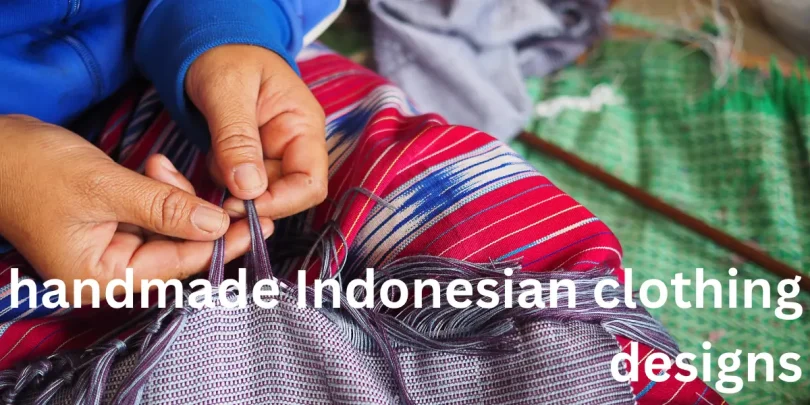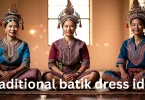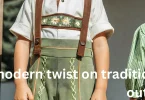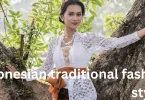Let’s be real—finding clothing that feels personal, meaningful, and stylish can be tough. Most of what we see in stores feels mass-produced, right? Everything looks the same, and there’s rarely a story behind what we wear. That’s why handmade Indonesian clothing designs are such a breath of fresh air. They’re not just clothes; they’re pieces of art that tell the story of Indonesia’s culture, creativity, and heart.
Whether you’re someone who loves unique fashion, appreciates handmade craftsmanship, or simply wants to wear something that stands for more than just style, this journey into the world of Indonesian handmade fashion will make you fall in love. So grab a cup of coffee, get cozy, and let’s chat about what makes these designs so special, how they’re made, and how you can embrace them with confidence and pride.
Why Handmade Indonesian Clothing Designs Are So Special
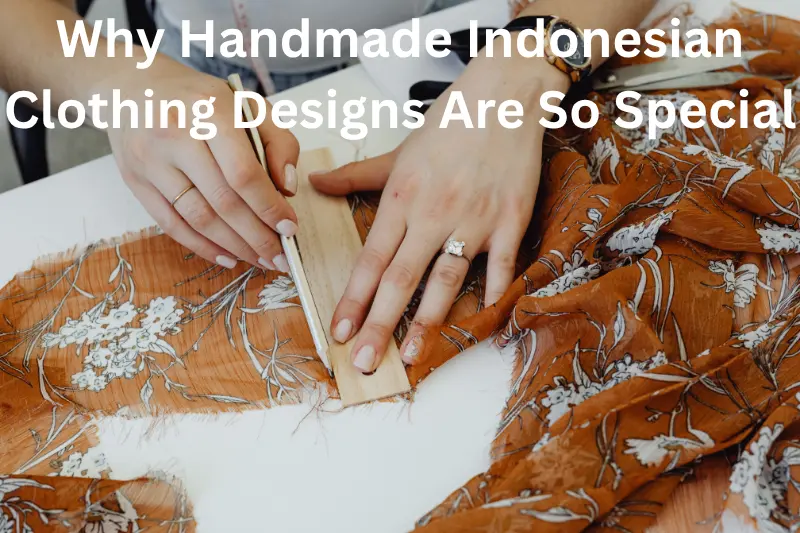
Real talk—there’s something truly magical about clothes that are handmade. They carry the maker’s energy, time, and dedication in every stitch. In Indonesia, that artistry runs deep. The designs aren’t just pretty; they’re rich with meaning, culture, and tradition passed down through generations.
Each region in Indonesia has its own signature patterns and techniques. Batik from Yogyakarta, ikat from Sumba, tenun from Bali—each piece reflects the story of the land and the people. Unlike fast fashion, these garments are made slowly, with care, and with respect for both fabric and heritage.
The best part? You’re not just wearing a dress or a shirt. You’re wearing a piece of history that supports local artisans and keeps traditional craftsmanship alive.
Understanding the Art of Batik and Tenun
Before you dive into the world of handmade Indonesian clothing designs, it helps to understand two of the most iconic techniques—batik and tenun.
The Beauty of Batik
Batik is one of Indonesia’s most famous textile arts, recognized by UNESCO as an Intangible Cultural Heritage. It’s a wax-resist dyeing technique that creates intricate patterns on fabric. Artisans use a canting (a small copper pen) or stamps to draw patterns with hot wax before dipping the fabric in dye. Once the wax is removed, what remains is a stunning, detailed design that looks like it was painted by hand—because it was!
Each region’s batik has a unique story and symbolism. For instance, batik parang from Yogyakarta symbolizes strength and persistence, while batik mega mendung from Cirebon represents peace and patience. These aren’t just random motifs; they carry deep cultural meaning and wisdom.
The Elegance of Tenun
Tenun, or handwoven fabric, is another Indonesian treasure. The process involves weaving colorful threads into complex patterns on a traditional loom. This can take weeks or even months, depending on the design. The result? A richly textured fabric that feels alive with color and movement.
Tenun is especially cherished in regions like Sumba, Flores, and Bali. Each weave tells a different story—of ancestry, local beliefs, and daily life. Wearing tenun is like wrapping yourself in the spirit of the archipelago.
The Emotional Value of Handmade Clothing

Let’s be honest—when you buy something handmade, it just feels different. There’s pride in knowing your clothes weren’t mass-produced by a machine but crafted by a real person whose skills were honed over generations.
Every stitch has intention. Every pattern has purpose. When you wear handmade Indonesian clothing designs, you’re connecting with that story. You’re saying, “I value time, tradition, and authenticity.”
And the best part? These clothes often last longer. Because artisans care about quality, they make sure each piece can withstand years of wear while maintaining its beauty.
Common Struggles When Choosing Handmade Indonesian Clothing Designs
If you’re new to the world of handmade clothing, it can feel a little overwhelming. Here are some real-life struggles many beginners face—and how to handle them.
1. Understanding the Price
You might notice that handmade pieces cost more than mass-produced ones. That’s because you’re paying for skill, time, and artistry. Each design can take days—or even weeks—to finish. Think of it as investing in wearable art rather than just buying another outfit.
2. Finding Authentic Designs
With the rise of global interest in Indonesian fashion, some brands sell “handmade-inspired” designs that aren’t actually handmade. The trick is to look for transparency. Authentic sellers usually share stories about their artisans, materials, and processes.
3. Learning to Style Them
Some people worry traditional designs won’t fit their modern wardrobe. But that’s the fun part! You can easily pair a tenun top with jeans, or style a batik skirt with a crisp white blouse. Mixing modern and traditional styles creates a look that’s both unique and timeless.
How to Style Handmade Indonesian Clothing Designs for Everyday Life
If you think traditional Indonesian fashion is only for special occasions, think again. These designs are super versatile.
For Casual Days
- A light batik blouse with denim jeans or linen pants.
- A tenun scarf over a plain tee to add texture and color.
- Batik shorts paired with a neutral crop top for a fun summer vibe.
For Work
- A tailored batik blazer or vest adds elegance to your office outfit.
- Tenun pencil skirts give a professional yet stylish look.
For Special Occasions
- A long tenun dress with subtle jewelry.
- A batik sarong paired with modern heels or flats.
No matter your style—minimalist, boho, or chic—you can always make handmade Indonesian clothing designs your own.
Supporting Local Artisans: The Heart of Ethical Fashion
Here’s the deal: when you buy handmade clothing, you’re doing more than upgrading your wardrobe—you’re empowering real people.
Most Indonesian artisans are part of small communities where weaving or batik-making is a family tradition. Buying from them helps preserve those skills and gives artisans fair income. It also keeps the younger generation inspired to continue the craft.
By supporting handmade fashion, you’re helping create a cycle of respect—for people, culture, and the planet. It’s fashion with purpose.
How to Identify Genuine Handmade Pieces
With so many imitations around, here are a few tips to spot the real deal:
- Look at the patterns: Authentic batik patterns have slight imperfections because they’re drawn by hand. Machine prints look too perfect.
- Feel the texture: Handmade fabrics like tenun feel textured, not flat. You can often feel the weave.
- Ask about the origin: Genuine sellers will proudly tell you where and how the fabric was made.
- Check for natural dyes: Many artisans use plant-based dyes, which give softer, more organic shades.
These small details make a big difference and help you appreciate the true artistry behind each piece.
Mixing Tradition with Modern Trends
Fashion is always evolving, and what’s beautiful about handmade Indonesian clothing designs is how effortlessly they blend with modern trends. Today’s designers are finding creative ways to bring these traditional fabrics into everyday fashion—think batik sneakers, tenun handbags, or even jackets with woven accents.
You can totally rock a modern outfit while keeping that traditional touch. The goal isn’t to look “ethnic”; it’s to express individuality through culture. When done right, it’s powerful and stylish at the same time.
Caring for Your Handmade Indonesian Clothing Designs
Because these garments are delicate works of art, they deserve a little extra love.
Here’s how to take care of them
- Hand wash gently with mild soap and cold water.
- Avoid direct sunlight when drying to protect the dyes.
- Store in a cool, dry place—preferably folded rather than hung.
- Never use harsh detergents or bleach.
A little care goes a long way in keeping your handmade clothes vibrant and beautiful for years to come.
Why Handmade Fashion Feels Empowering
There’s something deeply empowering about wearing something that’s made with purpose. It reminds you to slow down, appreciate the process, and connect with the hands that created it. It’s fashion that feels human again.
When you wear handmade Indonesian clothing designs, you’re not just expressing your style—you’re carrying stories, emotions, and heritage with you. And that’s something no mass-produced brand can replicate.
Conclusion: Your Journey with handmade Indonesian clothing designs
At the end of the day, choosing handmade Indonesian fashion is more than just a style choice—it’s a lifestyle. It’s about embracing authenticity, celebrating culture, and valuing the art of slow creation. You don’t have to be an expert to appreciate it; you just need curiosity and an open heart.
Every piece you wear connects you to a legacy—a reminder that beauty isn’t about perfection, but about passion, patience, and purpose.
So next time you’re tempted by fast fashion, pause and remember: there’s magic in what’s made by hand.
Quick Takeaway Checklist
- Learn about the story behind each piece you buy.
- Support local artisans and fair trade brands.
- Mix traditional designs with modern outfits confidently.
- Care for your clothes gently to make them last.
- Wear your handmade pieces proudly—they’re part of a living culture.
FAQs
What makes handmade Indonesian clothing designs unique
They are created by skilled artisans using traditional techniques like batik and weaving, making every piece distinct and rich in cultural meaning.
Are handmade Indonesian clothing designs sustainable
Yes, most are made with natural dyes and eco-friendly fabrics, promoting sustainable fashion and supporting local communities.
Can I wear handmade Indonesian clothing designs for modern occasions
Absolutely! These designs blend traditional artistry with contemporary cuts, perfect for casual wear, parties, or even formal events.
Where can I buy authentic handmade Indonesian clothing designs
You can find them through local artisans, online ethical fashion platforms, or directly from Indonesian boutique brands that support fair trade.
Why are handmade Indonesian clothing designs considered valuable
Each piece is made with time, care, and ancestral skill, turning every garment into a wearable work of art that celebrates Indonesian culture.

